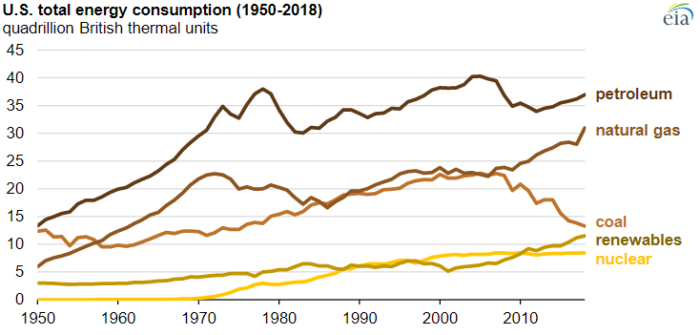According to EIA, primary energy consumption in the US reached a record high of 101.3 quadrillion British thermal units (Btu) in 2018, an increase of 4% from 2017 and 0.3% more than the previous record set in 2007. The increase in 2018 was the largest increase in energy consumption, in both absolute and percentage terms, since 2010.
Consumption of fossil fuels increased by 4% in 2018 and accounted for 80% of US total energy consumption. Natural gas consumption also reached a record high, growing by 10% from 2017. This increase in natural gas, along with relatively smaller increases in the consumption of petroleum fuels, renewable energy, and nuclear electric power, more than offset a 4% reduction in coal consumption.
[smlsubform prepend=”GET THE SAFETY4SEA IN YOUR INBOX!” showname=false emailtxt=”” emailholder=”Enter your email address” showsubmit=true submittxt=”Submit” jsthanks=false thankyou=”Thank you for subscribing to our mailing list”]
EIA also reported that petroleum consumption in the US increased to 20.5 million barrels per day (b/d), or 37 quadrillion Btu in 2018, up almost 500,000 b/d from 2017 and the highest level since 2007. Growth was driven mainly by increased use in the industrial sector, which rose by about 200,000 b/d in 2018. The transportation sector grew as well by about 140,000 b/d in 2018 as a result of increased demand for fuels such as petroleum diesel and jet fuel.
Regarding natural gas, its consumption in the US achieved a record high 83.1 billion cubic feet/day (Bcf/d), the equivalent of 31 quadrillion Btu, in 2018. Natural gas use rose across all sectors in 2018, mainly driven by weather-related factors.
As more natural gas-fired power plants started operations and existing natural gas-fired power plants were used more often, natural gas consumption in the electric power sector increased 15% from 2017 levels to 29.1 Bcf/d. Natural gas consumption was also higher in the residential, commercial, and industrial sectors in 2018, increasing 13%, 10%, and 4% compared with 2017 levels.
Moreover, coal consumption in the US reduced to 688 million short tons (13 quadrillion Btu) in 2018, which is the fifth year of decline in a row. About all of the reduction derived from the electric power sector, which fell 4% from 2017 levels. Coal-fired power plants are still displaced by newer, more efficient natural gas and renewable power generation sources. In 2018, 12.9 gigawatts (GW) of coal-fired capacity were retired, with 14.6 GW of net natural gas-fired capacity being added.
Additionally, renewable energy consumption reached a record high 11.5 quadrillion Btu in 2018, increasing 3% from 2017, largely driven by new wind and solar power plants. Wind electricity consumption rose 8% while solar consumption grew 22%.
Biomass consumption, mainly in the form of transportation fuels such as fuel ethanol and biodiesel, accounted for 45% of all renewable consumption in 2018, a 1% increase from 2017 levels. Increases in wind, solar, and biomass consumption were partially offset by a 3% reduction in hydroelectricity consumption.
Finally, nuclear consumption increased less than 1% in comparison to 2017 levels but still set a record for electricity generation in 2018. Furthermore, the number of total operable nuclear generating units decreased to 98 in September 2018. Annual average nuclear capacity factors, which represent the use of power plants, were slightly higher at 92.6% in 2018 compared with 92.2% in 2017.
See further details in the PDF below
































































